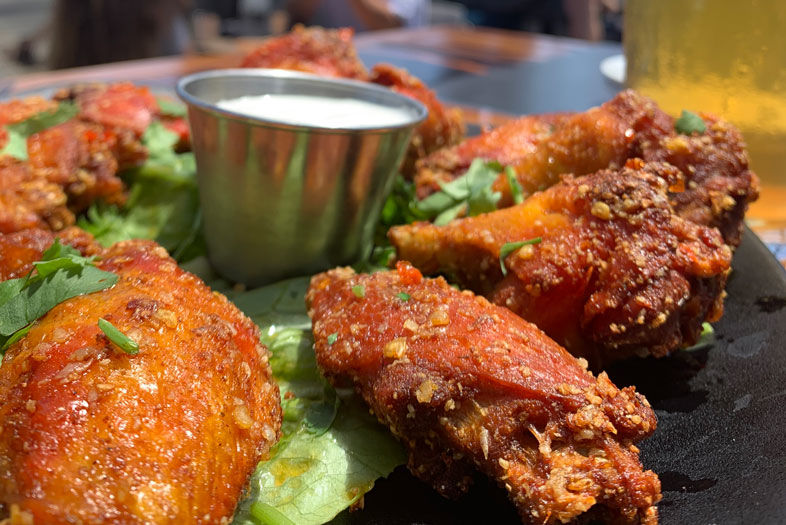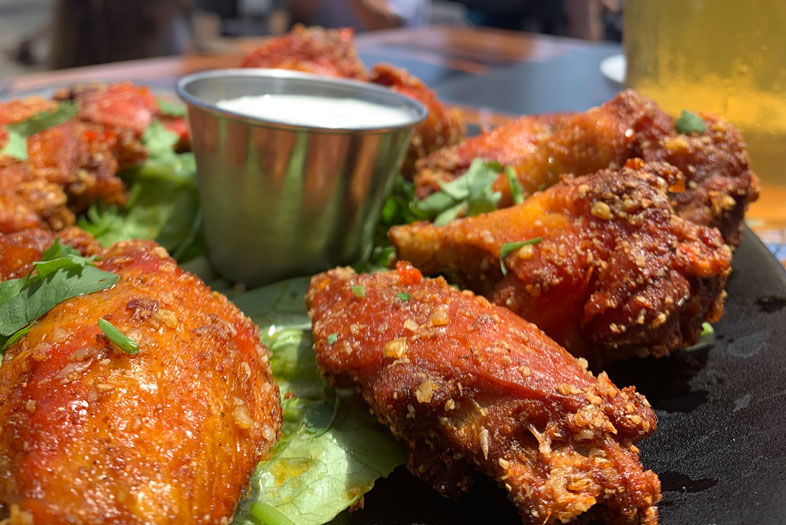How chicken wings did it is lost in the crinkled, rust-colored wet wipes of history. But at some point, they became the official food of the most popular professional sport in the United States. Hot dogs have a choke hold on baseball (the third most popular sport at 9 percent), the official food of hockey is presumably whatever you can eat without teeth, and wings absolutely own professional football (far and away the U.S. favorite at 37 percent).
The National Chicken Council runs an index of how many wings Americans will eat during each Super Bowl. Last year it was 1.35 billion. That’s an average of four wings per U.S. citizen. We’re kind of gross, and awesome, simultaneously.
It wasn’t always this way. In fact, wings used to be the part most restaurateurs used for stocks and soups. They were the unwanted, the Rudy of the chicken (Rudy! Rudy! Rudy!). Then in 1964, Theresa and Frank Bellisimo, owners of Anchor Bar in Buffalo, New York, cut them into three parts (wing, drumette, and tip), deep fried them, and slathered them in a vinegar-peppers-butter sauce. The Bellisimos told famed writer Calvin Trillin that they’d received a box of wings by mistake (they’d wanted the backs and necks for spaghetti sauce), and made do. Another story is that it was a late-night snack for their son and his college friends, or that they were made as treats for Catholic patrons after their various meat-fastings.
There are other creation stories. Always are. Famous foods are like orphans who grow up to be celebrities—everyone comes out of the woodwork and claims to have made this child.
No matter the truth, the blue collar people of Buffalo went berserk for this blue-collar bar food. Wings went viral. Buffalo went from being best known as the city bullied by unrelenting snow, to the city with the magical meat snack. The mayor even campaigned for the city’s official symbol to be a wing, and for a statue to be erected at the Convention Center.
Wings became so popular that they’re now the most expensive part of the chicken. Until science figures out how to create chickens with hundreds of wings (we’re probably pretty close with genetics, but let’s please not do this for the love of god), each chicken can only grow two wings at a time. To keep up with demand, restaurateurs came up with “boneless wings,” which are small pieces of breast meat, fried and sauced to look like wings. That’s right. Boneless wings are not wings at all. I’m so sorry to have broken this news to you.
Part of wings’ appeal, I’d argue, is the mutually agreed upon social contract of messy eating. We live in a hand sanitizer world. Manners and tiny forks suck all the joy out of life, like that one crossing guard kid we all remember who took his job far too seriously. It feels liberating to be slathered with our food. It’s a food you have to dress for. You pick out the clothes whose role in your wardrobe is “wearable napkin.”
We all agree to eat like cave people in a nonjudgmental wing zone supported, emotionally, by ice cold beer.
All this is to say that I’ve started my month-long search for the best wings in San Diego. Buffalo deserves credit for the popularization, but I’m not limiting it to that style. I’m including Korean fried chicken wings, salt-and-pepper wings, wings at dive bars and wings at four-stars. My fiance, a lifelong New Yorker, is not happy about this. Two nights ago we spellunked through five Asian restaurants testing wings, and she questioned their qualifications for this crucially important survey. To her, and to many New Yorkers, there is only one wing. It’s the only time I’ve ever heard her sound like a nativist.
My search starts with the wings I named the best in the city in this year’s “Best Restaurants” issue—the crispy, juicy, peanut-and-chile wings at O.B. Noodle House. They are a wonder. But never rest on your laurels when it comes to wings. Greater greatness may be out there.
THE SEARCH IS OVER… CLICK HERE FOR THE FULL LIST OF THE BEST WINGS IN SAN DIEGO.

PARTNER CONTENT
The Hunt For San Diego’s Best Chicken Wings











